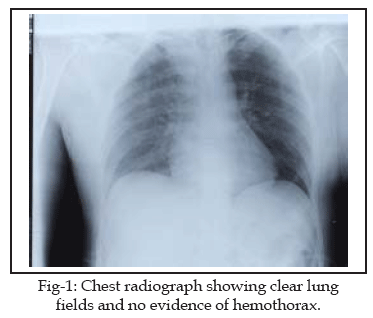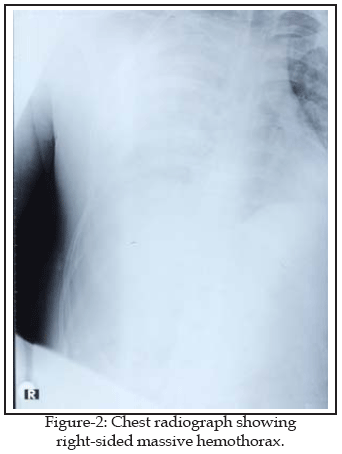|
|
||||
|
Published by : PROFESSIONAL MEDICAL PUBLICATIONS |
||||
|
ISSN 1681-715X |
||||
|
||||
|
- |
||||
|
CASE REPORT |
||||
|
- |
||||
|
Volume 25 |
October - December 2009 (Part-I) |
Number 5 |
||
|
|
||||
|
||||
|
|
||||
|
Published by : PROFESSIONAL MEDICAL PUBLICATIONS |
||||
|
ISSN 1681-715X |
||||
|
||||
|
- |
||||
|
CASE REPORT |
||||
|
- |
||||
|
Volume 25 |
October - December 2009 (Part-I) |
Number 5 |
||
|
|
||||
|
||||
Management of penetrating
superior caval vein injury
Hasan EKIM1
SUMMARY
Penetrating injuries to the superior caval vein (SCV) are rare but are very serious. They can be associated with hemodynamic instability and often produce a substantial technical challenge to the surgeons. We report a case of 32-year old man who was admitted to our hospital having sustained multiple stab wounds over the right chest wall and extremities. Many victims of penetrating thoracic trauma with SCV injury are in profound shock, whereas our patient on arrival in the emergency department had a stable condition, so the diagnosis was delayed. We consider that associated mediastinal pleural adhesions confined the bleeding into the mediastinum which prevented prompt massive bleeding. Therefore he tolerated a preoperative delay of six hours. Caval injury should be kept in mind in the differential diagnosis of hemothorax.
KEY WORDS:
Superior Caval Vein Injury.Pak J Med Sci October - December 2009 (Part-I) Vol. 25 No. 5 869-871
How to cite this article:
EKIM H. Management of penetrating superior caval vein injury. Pak J Med Sci 2009;25(5):869-871.
1. Hasan EKIM, MD,
Dept. of Cardiovascular Surgery,
Yuzuncu Yil University, Tıp Fakültesi Hastanesi
Maras Caddesi 65200 VAN/Turkey.
Correspondence
Dr. Hasan Ekim
E-Mail: drhasanekim@yahoo.com
* Recevied for Publication: May 6, 2009
* Accepted: August 12, 2009
INTRODUCTION
Penetrating injuries to the superior caval vein (SCV) are rare but very serious. They can be associated with hemodynamic instability and hemothorax.
1 Most victims die of exsanguinations, because control and repair of profuse bleeding from the thin-walled vena cava poses an arduous technical challenge to the cardiothoracic surgeon.2Our patient with SCV injury developed a delayed right hemothorax after six hours of admission. He was successfully operated and recovery was uneventfully. To the best of our knowledge, this is the first report of such a case.
CASE REPORT
This-32-year old man was brought to the emergency department of our hospital having sustained multiple stab wounds over the anterior aspect of the right chest wall and extremities. On admission his blood pressure was 90/60 mmHg, with a pulse of 80 beats per minute and respiratory rate of 18 per minute. He was hemodynamically stable. His breath sounds were equal bilaterally, without rhonchi or rales. The heart sounds were regular, and, there were no murmurs, rubs, or gallops. Chest radiograph taken on admission did not show any marked abnormality (Fig-1). The emergency routine laboratory investigations were normal.

Six hours after the admission, the patient became acutely hypotensive with associated tachycardia and tachypnea. A repeated chest radiograph revealed massive hemothorax (Fig-2). A right tube thoracostomy was performed. Approximately 1800 ml of blood was evacuated. The tube was occluded with a clamp and he was immediately taken to the operating room and intubated. A right anterolateral thoracotomy was performed through the fifth intercostal space and a large amount of clot was evacuated. We discovered that right lung was adhesive to the mediastinum and diaphragma. The lung was separated from these adhesions by blunt and sharp dissection. After pulling back the lung, we found a large compressive hematoma infiltrating the mediastinum. When this hematoma was removed, a massive caval bleeding was discovered. Digital control was established. The pericardium was opened due to a pericardial laceration. However, myocardium was intact. Two longitudinal tears were identified at the anterior and posterior walls of the SCV (approximately 1.5 cm in lengths). The tip of central jugular venous line was found to be situated in the mediastinum through caval rupture. It was removed by anesthesist.

After giving 5.000 units of heparin intravenously, two vascular clamps were placed on the SCV to prevent bleeding. The anterior and posterior wounds were repaired with running 5.0 polypropylene sutures. At the end of the vascular repair, there was a slight stenosis of the SCV. In addition two deep pulmonary lacerations (3cm & 2cm in length) were found. They were repaired with 3.0 Vicryl sutures. The incision of the thoracotomy was closed in the standard manner. The patient was transferred to the cardiac intensive care unit and extubated six hours after operation. He had slight facial swelling and it resolved in a few days.
He was treated empirically with intravenous sephazoline sodium for five days due to contaminated nature of the injury. On the eleventh postoperative day, he was transferred to the department of orthopedics and tendinous injuries were repaired. He continues to do well 18 months after surgery.
DISCUSSION
SCV injuries are usually not easily repaired: massive bleeding from the thin walled vena cava is not easily controlled and the application of vascular clamps to be a bleeding site can often aggravate the injury.
2,3 However, clamping of injured SCV is imperative & fundamental to gain prompt control of bleeding sites, but caval vein injuries often produce a substantial technical challenge to the cardiothoracic surgeons. Therefore, care should be exercised to avoid clamp-induced injuries to the thin walled cava.4Operative exploration is usually required urgently. The approach is usually dictated by the clinical presentation. A massive hemothorax mandates a right thoracotomy,
5 as was done in this case. Ligation of the SCV is not the best management option, because it usually results in severe cerebral and upper limb edema.5 Additionally, acute diminution in cardiac output due to diminished venous return to the right atrium may not be tolerated in severely injured victims.3 However successful ligation of the jux-ta-atrial portion of the SCV has been reported.6 Superior intercostals veins, azygos & hemiazy-gos veins may have constituted alternative pathways to the heart.3 If few or no collateral veins provide significant drainage of the upper body, prolonged intraoperative clamping of the SCV can result in potentially fatal cerebral edema or postoperative neurologic deficits.7The majority of caval injuries can be repaired without the need of cardiopulmonary bypass (CPB), as was done in our case. However, median sternotomy and CPB may be required for injuries close to the heart where distal control is not tolerated and can be helpful in decompressing the venous system and allowing improved exposure.
5Many victims of penetrating trauma with SCV injury are in profound shock, whereas our patient on arrival in the emergency department had a stable condition. We consider that associated mediastinal pleural adhesions confined the bleeding into the mediastinum and prevented prompt massive bleeding. Therefore he tolerated a preoperative delay of six hours.
Although control of caval injury may be difficult, careful surgical technique and application of basic trauma and cardiovascular principles can salvage this injury.
4 If possible caval injuries should be repaired with lateral venorrhaphy. Narrowing of the cava during lateral venorrhaphy has been of some concern to some surgeons, but this was not a problem in one patient whose caval diameter was decreased to 20% of normal and remained patent.2 Additionally, various materials (gortex, pericardium, saphenous vein) may be used as a patch graft to prevent luminal narrowing.Gortex graft may be superior to other synthetic grafts for caval vein replacement by reason of good pseudointimal formation and minimal tissue reaction around the grafts.
8 However, there are some risks associated with using a PTFE graft for SCV reconstruction, including the need for postoperative anticoagulation, risk of infection and thrombosis.9 Therefore, we have avoided synthetic grafts for caval or other venous reconstruction, if possible. Another alternative that is appealing is the use of stent graft. However, placing a longer length stent graft to the injured SCV could potentially lead to thrombosis of the upper extremity veins.1CONCLUSION
Penetrating injury of the superior caval vein is a thoracic vascular emergency that should be treated immediately to prevent death. However, the possible undiagnosed pulmonary infection causing pleural adhesions may have saved our patient by playing an important role to prevent massive bleeding of the SVC wounds, by means of a global compression. Similarly occurrence of extensive thoracic wall adhesions and initial hemopneumothorax may also be prevented . Eventually, these adhesions were released due to continued bleeding, as seen in this case. Therefore, caval injury should be kept in mind in the differential diagnosis of hemothorax and surgical intervention should be performed promptly. Also, our familiarity with traumatic cardiothoracic procedures may have also been a factor in the success of this procedure.
REFERENCES
1. Azizzadeh A, Pham MT, Estrera AL, Coogan SM, Safi HJ. Endovascular repair of an iatrogenic superior vena caval injury: a case report. J Vasc Surg 2007;46:569-571.
2. Kudsk KA, Bongard F, Lim RC. Determinants of survival after vena caval injury. Arch Surg 1984;119:1009-12.
3. Jancovici R, Dubrez J, Lang-Lazdunski L, Brinquin L, Pons F. Superior vena cava gunshot wounds: Succseeful management. J Cardiovasc Surg 1996;37:535-537.
4. Bakaeen FG, Wall MJ, Mattox KL. Successful repair of an avulsion of the supwerior vena cava from the right atrium inflicted by blunt trauma. J Trauma 2005;59:1486-8.
5. Shah SSA, Heffernan DS, Howdieshell TR, Dietl CA. Two stage reconstruction of the superior vena cava after gunshot to the chest. J Trauma 2006;61:736-8.
6. Robbs JV, Reddy E. Management options for penetrating injuries to the great veins of the neck and of superior mediastinum. Surg Gynecol Obstet 1987;165:323-6.
7. Singh S, Sherif H, Reul GJ. Reconstruction of the superior vena cava. Tex Heart Inst 2000;27:38-42.
8. Fujiwara Y, Cohn LH, Adams D, Collins JJ. Use of gortex grafts for replacement of the superior and inferior venae cavae. J Thorac Cardiovasc Surg 1974;67:774-9.
9. Jones DR. Technique of superior vena cava resection for lung carcinomas. Operative Techniques in Thorac Cardiovasc Surg 2008;13:274-82.
HOME | SEARCH | CURRENT ISSUE | PAST ISSUES
Professional
Medical Publications
Room No. 522, 5th Floor, Panorama Centre
Building No. 2, P.O. Box 8766, Saddar, Karachi - Pakistan.
Phones : 5688791, 5689285 Fax : 5689860
pjms@pjms.com.pk